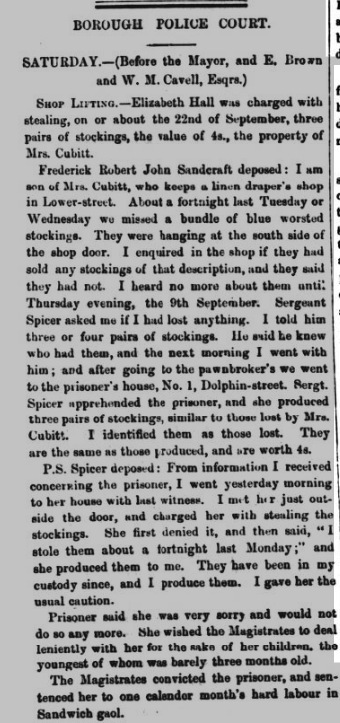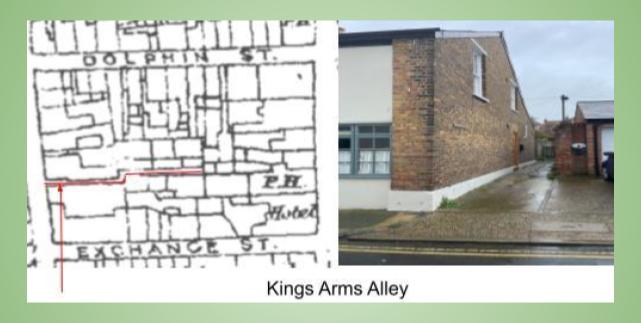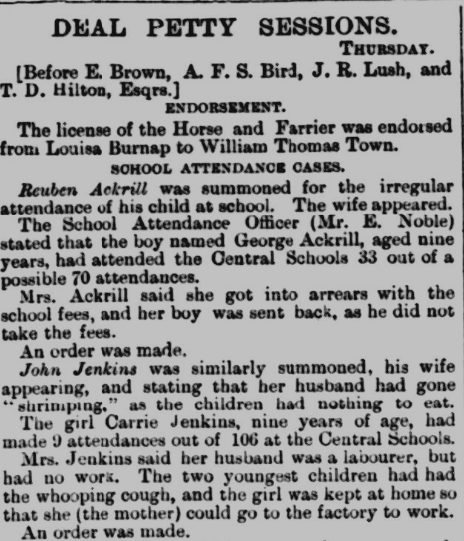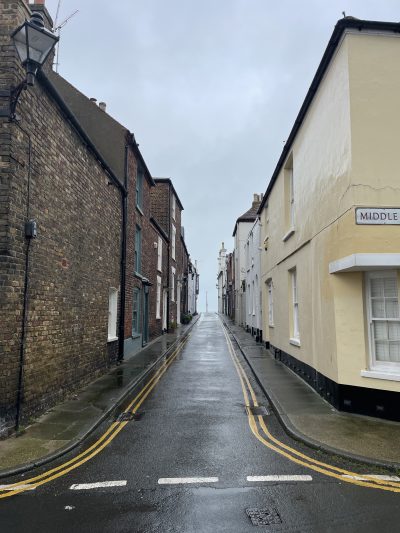Follow us on Facebook @FHofDW
A House on Dolphin Street
and the
People Who Lived There
Our research for the house in Dolphin Street started because of an indentured document dated 1770 found in Deal Museum. At first glance we thought the document was a deed.

However on closer inspection we found it to be a ‘Mortgage by Demise’. Most of us are familiar with the term ‘mortgage’ which basically is, in today’s terms, a loan from a bank or building society that lets you buy a property. The loan is secured, which means the bank has the right to take back and sell the property if you don’t keep up with the agreed repayments.
A ‘Mortgage by Demise’ is a temporary transfer of property in order to secure a loan of money and is usually over a long period of time, in this case 500 years. As the ownership or ‘title’ of property has been transferred to the person lending the money they have the right to enter and use the property or as our document says to “…peaceably and quietly to enter into and upon and to have hold use occupy posses and enjoy the said Messuage or Tenement yard or backside and premises…” Also if the ‘borrower’ did not make the agreed repayments then the ‘lender’ could put the property up for sale.
The Dolphin Street House
Dolphin Street sits in the Manor of Chamberlaines Fee and forms the boundary with the neighbouring Manor of Deal Prebend.
It is unclear as to when our house was actually built. What is clear is that it is brick built using the Flemish Bond.
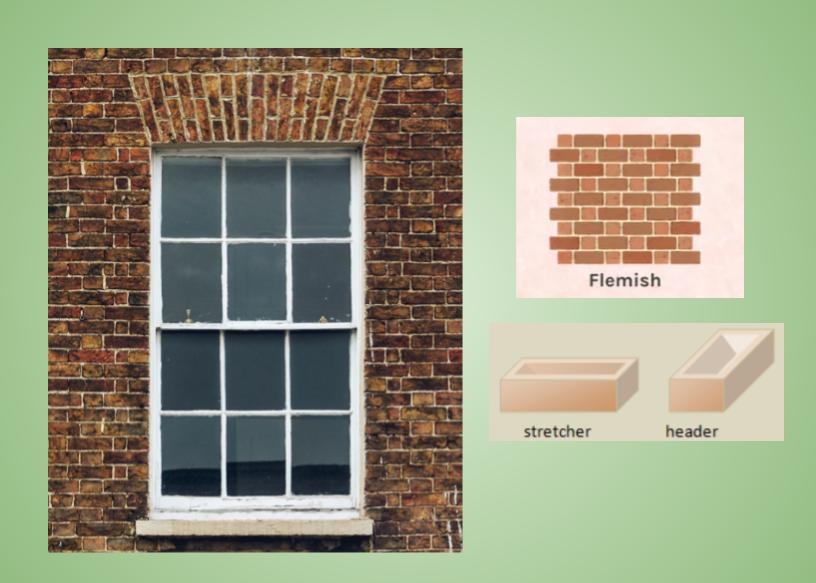 This style of building started to become popular after the Restoration of the Monarchy in 1660. The court of Charles the second brought with it, from the Low Countries, new ideas including the use of brick for housing.
This style of building started to become popular after the Restoration of the Monarchy in 1660. The court of Charles the second brought with it, from the Low Countries, new ideas including the use of brick for housing.
After the perils of timber-framed construction was highlighted by the Great Fire of London in 1666, brick became a popular choice for house building.
As production increased, brick became affordable and brickfields were opened up across the country including in Deal.
Our house also has sash windows. These were introduced in the late 17th century so the overall style of the house suggests late seventeenth early eighteenth century fitting in with the building boom that occurred in Deal, giving us the area we now know as the Middle Street Conservation area.
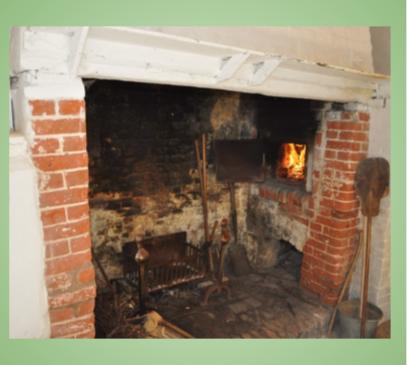
An Example of an Inglenook Fireplace with a bread oven to the right, other bread ovens were built to face into the room.
According to the 1911 census our house then had five rooms, so probably three bedrooms, a kitchen and living area.
The house still has a wonderful original inglenook fireplace in its front room which may have been the original hearth built for open cooking, before the cast iron stoves of the Victorian era took over. There may also have been a bread oven to one side but if so all traces have gone.
Mortgage of Demise
This ‘Mortgage by Demise’ was taken out by one Richard Selth borrowing the sum of forty pounds from Richard May in 1770. We don’t know why he borrowed the money but if he used the Dolphin Street house to secure the loan then he must have had the right to do so.
We know that by 1790 he owned our house as he is listed as the ‘freeholder’ in the Poll book (voters list) for June that year.
A Mortgage of Demise, as with most documents of this type, records other incidental information, including who was then living in the property and who the immediate neighbours were. It also gives the occupations of the lender and borrower and in which town they reside. So from our document we know that Richard Selth was a Mariner, Richard May was a Baker and both were from Deal.
Richard was born in Deal, his mother Mary Snoswell was a widow when she married his father in January 1744. Before their marriage there doesn’t appear to have been any Selths’, or those of similar names, in the town at all. The first record of a Selth in Deal was the marriage between Richard’s parents, William and Mary.
Mary gives us our first little mystery. Her maiden name may have been Fossey. We say ‘may’ because the only marriage of a person with the first name of Mary to another with the surname of Snoswell was a Mary Fossey in 1732 in Deal.
Further research turned up a will for Mariner John Snowsell of HMS Eltham. He died in 1742 and left all his worldly goods to his “…loving wife Mary Snowsell of Deal…” so the marriage of widow Mary Snoswell to William Selth 1744 fits. But where and when she was born has eluded us. It could simply be that she was baptised as a non-conformist and those records have not survived.
Richard Selth himself married Margaret Petman in July 1769 and by the time he took out this ‘mortgage’ his first child had been born. Where they were living at that time, we simply don’t know but Richard’s father, William Selth, is mentioned in the document as living to the West (that is next door) of our house. The couple went on to have nine children all of whom lived into adulthood.
As Richard is listed as the head of the household in the 1801, 1811 & 1821 census’, it seems that the house was or became the family’s home.
Richard died in Dolphin Street in 1829, Margaret though outlived him by two years, by which time she was living on Beach Street with her widowed daughter, Mary Long.
Snoswells
In the document it is stated that our house was “…now or late in the tenure or occupation of Elizabeth Snoswell Widow…” Here lies a second mystery. Who was Elizabeth Snoswell?

We started our search for Elizabeth by looking at marriages and found none. Then the baptisms of Snoswell children, in Deal, whose parent’s names were Elizabeth and Thomas of which there were seven.
In the surviving rates books Thomas Snswell is listed as paying 4 1/2d in 1748 and 3d in 1749. However these do not give a street name, only the person paying the rates. He is also listed in the Window Tax list of 1763 which shows he paid the 2s tax. William Selth, Richard’s father, and Robert Ashenden are also listed, and as they also appear as near neighbours on the 1801 census, it suggests this Window tax list, although not following the Streets house order, is for Dolphin Street and, if so, Thomas was then living in our house.
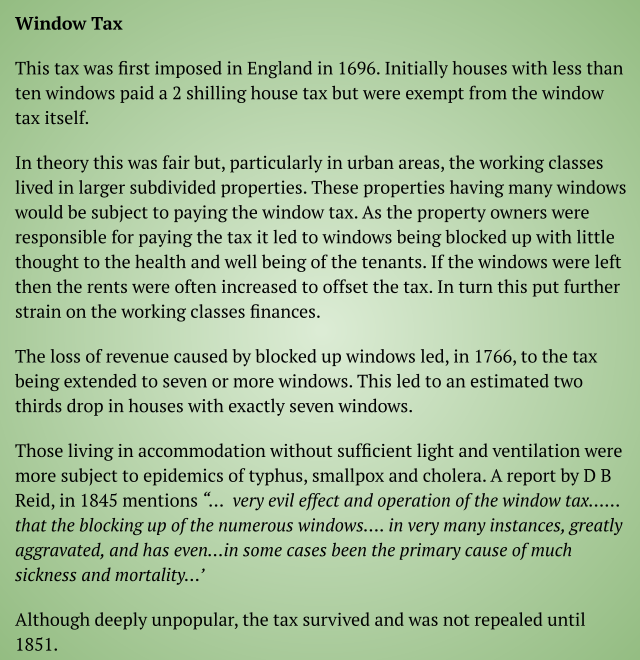
Although we couldn’t find a marriage between Elizabeth and Thomas we did find his death in 1766 and a possible first marriage, in 1745 to Joanna Willams nee Kiplin(g).
Joanna and Thomas had three children but all died as mere babies. Then in 1753 Joanna also died. What caused their deaths would just be speculation but for Thomas losing his family did not end there. He and Elizabeth had seven children born between 1755 and 1765, in 1766 death struck again. In that year they lost three of their young children then Thomas lost his own life. Unimaginably death visited our Dolphin Street house once again that year taking a fourth child from Elizabeth just before that Christmas.
Thomas’ will, if he left one that is, has not survived so we may never know if he actually owned the freehold or lease to his home and if he left it to Elizabeth hence her appearing on the Mortgage by Demise.
The Wells and Hall Family
If Richard left a will then it too hasn’t survived, or at least come to light, and as Margaret at the time of her death was living on Beach Street then it is fair to say that another family must have moved in soon after Richard’s death. We know that one Thomas Wells died in Dolphin Street in 1835. But if that was in our house we don’t know for sure, we do know though that in the 1839 baptism register, Elizabeth Sarah Wells, the daughter of Sarah Wells, nee Foster and Henry Edward Wells was living in Dolphin Street and from the subsequent census records that they were living in our house.
Henry is another of this house’s mysteries as he too disappears from the records after being recorded as the father to Elisabeth Sarah at her baptism.
In 1841 Sarah seems to have taken in lodgers to support herself and her young daughter; Elizabeth Goodwin a sixty five year old lady who had a small amount of personal income, to pay for whatever lodgings that Sarah was offering, and a twenty five year old mariner Phillip Bowbyes.
Elizabeth Goodwin died the following year but Phillip continues to lodge with Sarah and is still there in 1851 when that year’s census was taken in which Sarah describes herself as a ‘Mariners Widow’. By then another mariner, John Wells is living with them as is a servant named Elizabeth Foster.
Most of the residents of this household seem, in one way or another, to have been related to each other. Elizabeth Foster is Sarah’s unmarried sister and Philip Bowbyes, who died there in 1857, is their fathers step brother and, it is just possible, that John Wells is Sarah’s brother-in-law. Finally as Sarah’s mother’s maiden name was Goodwin it is also possible that Elizabeth was a widowed relation. Quite where all these people slept is not known but having a private or personal space then was a rare luxury reserved for the more affluent members of society.
After Philip’s death Sarah took in another Lodger, a sixty nine year old Boatman named Thomas Norris. Sarah by now was taking in washing to supplement her income, with the help of her daughter, Elizabeth Sarah.
When Thomas moved out is not clear but in 1862 Elizabeth Sarah, married Boatman James Frederick Hall. He may then have moved into our house as, on the baptism record for their eldest daughter Elizabeth Sarah born in 1865, they are living in Dolphin Street. Sadly a year later Sarah died and was buried in Hamilton Road Cemetery, she was sixty three years old.
We know that in 1871 the Hall family were still in our house. By now they’d had another daughter Eliza and still lodging with them was John Wells. They also had a servant, eleven year old Elizabeth Parsons.
 In mid 1873 a third daughter was born to James and Elizabeth, they named her Harriet Ann. Her baptism was held at St. George’s Church on 9th October but a few weeks before her daughter’s baptism, Elizabeth had a moment of madness! Just over a week after her daughter’s baptism Elizabeth was in the Magistrates Court charged with stealing three pairs of blue worsted stockings from the Mrs. Cubbit’s Linen Store at 171 Lower Street , Merry Gardens the Florist, 96 High Street.
In mid 1873 a third daughter was born to James and Elizabeth, they named her Harriet Ann. Her baptism was held at St. George’s Church on 9th October but a few weeks before her daughter’s baptism, Elizabeth had a moment of madness! Just over a week after her daughter’s baptism Elizabeth was in the Magistrates Court charged with stealing three pairs of blue worsted stockings from the Mrs. Cubbit’s Linen Store at 171 Lower Street , Merry Gardens the Florist, 96 High Street.
Elizabeth admitted the charge and asked for leniency but none was given. Perhaps today we would look to the cause and may even suggest a form of post natal depression and treatment but Elizabeth was sentenced to Sandwich Gaol for one month with hard labour. Hard labour for Elizabeth probably meant she was picking oakum or working in the laundry.
By 1880 the family had moved into nearby Kings Arms Alley and for Elisabeth and James things didn’t turn out well. Elizabeth died in 1886 and it seems the two youngest, Frederick and Harriet, went to live with James’ sister in Brighton. Their eldest daughter, also named Elizabeth Sarah, found employment as a kitchen maid in a Brighton Boarding House. Eliza aged ten in 1881 was already living with Mariner John Norris in Farrier Street and working as a servant. James himself died in Eastry Union Workhouse in 1898 he was fifty seven years old.
Thomas Cribben
We know that Thomas Cribben and his family had moved into our house, from 3 Exchange Street in 1880 and that he too was a Boatman, Thomas, though had moved out by 1885.
His friend and fellow boatman George Philpott moved and a few years later, in 1888, his wife, Mary Read, nee Humble, died, aged seventy four. It seems that throughout their married life they too had family living with them as lodgers. In 1891 George still had his brother in law Thomas Read Humble living with him. This Thomas, though, spent the last days of his life in Eastry Union where he died in 1895. George may have died at around the same time but no definitive death record can be found. He certainly was still in our house in September 1892 when his son died in America and a death notice was placed in the Deal, Walmer & Sandwich Mercury.
Just a week later the sale and purchase of our house, for £51, was also announced in the local paper. The purchaser and therefore the new owner was a Mr J. W. Silver.
Ambrose Pack Harper
Up until 1896 our house was very much the home of mariners or boatmen. Then for the first time in its history a former Marine, Ambrose Pack Harper, took up residence.
Ambrose started his military career at the Walmer Barracks in 1872 and after twenty years service he found himself back there for his final posting. Soon afterwards he met and married the widowed Louisa Finnis nee Charlton in Walmer. Ambrose may have found employment as a Fish Hawker. Sadly Louisa died in 1902; Ambrose continued to live in our house until around 1907 when he moved to Northbourne.
John Jenkins
Labourer John Jenkins then moves in with his family. John ‘s actual place of birth took some tracking down as in whatever town he lived in, at the time the census was taken, he gave that as his place of birth. Eventually though we found that he was born in Maidstone, where his mother was born, and that he was baptised in St. Margarets, Rochester where his father had found work as a farm labourer. By 1861 the family were living in Dover.
John in 1873 married seventeen year old Elizabeth Redsull whose father’s name , according to the parish marriage register, was William. Being under age she would have needed her fathers or guardians permission to marry. However, so far, no Elizabeth Redsull with a father of that name can be found in the records! Another little mystery!
In 1881 John and Elizabeth were still living in Dover and by 1891 they had moved to Deal and were living in Exchange Street with their four children all of whom, including themselves, say they were born in Deal! John at this point was a Bricklayers labourer.
As Ambrose P Harper moved out of our house in around 1907 it is quite possible that John moved his family into our Dolphin Street house soon after. They were living there by the time the 1911 census was taken when John was still labouring and Elizabeth was working as a monthly nurse. This being a person who cared for a mother in the first ’month’ after she had given birth.
Prior to their move into our house we know from newspaper reports that John and Elizabeth were struggling to support their young family. In 1891 and again in 1892 they were summoned for their children’s non attendance at school.The 1880 Education Act had made school attendance compulsory between the ages of five and ten. Elizabeth was probably working at the nearby Canning Factory on Sandown Road, and not able to afford time off to care for her sick children kept her eldest daughter at home to do so.
Is not clear when the family left our house or where they went afterwards. There is a John Jenkins who is registered as dying in 1912, so it is likely that this was our John and that this is when the family left our house. Quite who then moved is not exactly clear.
A Selth Returns to the House
Annie Maria Selth was born in 1862 , she was descended from Richard Selth’s brother, Valentine. In 1881 she gave birth to an illegitimate son who she named George Frederick Hills Selth. Seven years later she married John E. W. Dean and George then took his stepfather’s surname.
George became a plumber and in 1903 he married Annie Amelia Stanton. By 1909 they had two children. In 1911 they were living in Middle Street and George was then the Caretaker at Stanhope Hall, now Astor Theatre.
In December 1915 he enlisted and joined the Royal Engineers Inland Water Transport Section. The Deal Directory for 1915 states that George was the resident of our house however he gives an address in Cardiff and his occupation as a Seaman. Perhaps this was a lodging address.
We know the family were living in Dolphin Street in 1917 as, sadly, Annie Amelia died there of Pneumonia; she is buried in Hamilton Road Cemetery. Her mother in law Annie Maria nee Selth, was with her and it can be assumed that she then took in her grandchildren.

So yet again our house was in need of new occupants. In 1906 Frenchman Marcel Fouet, a waiter, married Annie Grace Longley in Bermondsey. The 1911 census shows the couple had moved to Deal with their three children; a fourth was born at the end of the year followed by two more. Marcel served in the Army Service Corp. during WW1.
The family were still living in our house when the 1939 register was taken at which time Marcel says he was a Watchman on light duties, perhaps factory nightwatchman, and Annie was a lavatory cleaner. So our house yet again has a family making ends meet. The Fouet family in around 1943 they move to Slough where they remained until their deaths in 1980 when they again returned to Deal to be buried in Hamilton Road Cemetery.
Who and when the next occupants were not known but the house survived the shelling and bombs of the second world war and remains a family home to this day.




